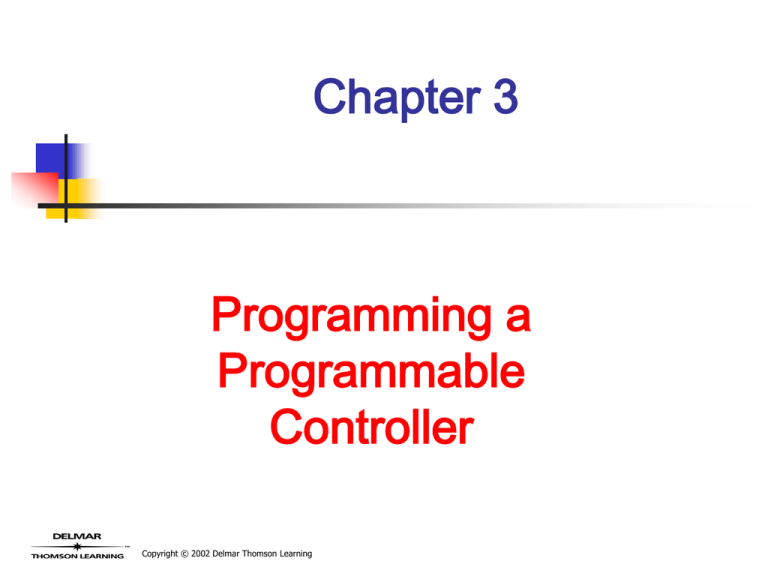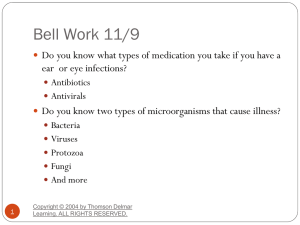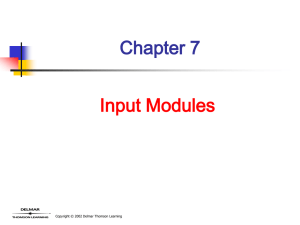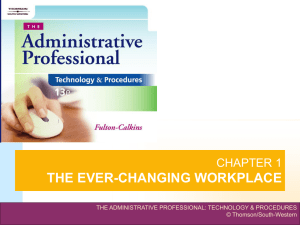CHAPTER 3
advertisement

Chapter 3 Programming a Programmable Controller Copyright © 2002 Delmar Thomson Learning Objectives Describe the available options for programming a PLC. Explain what online is in comparison to offline. List the advantages of software programming with a personal computer over a handheld programming terminal. Copyright © 2002 Delmar Thomson Learning Objectives (cont’d.) Explain the differences when interfacing a notebook personal computer to a PLC. Discuss open or soft PLC programming. Provide an overview of the IEC 1131-3 standard. Copyright © 2002 Delmar Thomson Learning PLC Run Mode The PLC can do nothing without someone developing a program and loading it into the PLC processor’s memory. Once the program has been loaded into PLC memory the processor is put into run mode. While in run mode, the processor is solving the ladder program. Copyright © 2002 Delmar Thomson Learning PLC Run Mode (cont’d.) While in run mode, the processor reads field device input signals and stores them in memory. There is one memory location for each input screw terminal’s on or off state. Field device status information is stored in the input status table. Copyright © 2002 Delmar Thomson Learning PLC Programming Oldest programming method is the handheld programmer. Most popular programming method is IBM-compatible personal computer using either DOS or Windows software. Higher-end PLCs can only be programmed using software. Copyright © 2002 Delmar Thomson Learning Allen-Bradley SLC 500 Programming Options Copyright © 2002 Delmar Thomson Learning Image courtesy of Allen-Bradley, a Rockwell Automation business Allen-Bradley SLC 500 Handheld Terminal (HHT) Copyright © 2002 Delmar Thomson Learning Image courtesy of Allen-Bradley, a Rockwell Automation business Handheld Programmer and SLC 500 Modular Processors Handheld used only on fixed SLC 500, 5/01 and 5/02 processors. 5/03, 5/04 and 5/05 modular processors allow software programming only. MicroLogix 1000 PLC has own handheld programmer. Copyright © 2002 Delmar Thomson Learning Smart Handheld Programming Terminal Advantages Compact size. Easy to use and learn, no software required. Low cost; cheaper than notebook computer. Easy to transport a program to the field. Easy to transfer PLC program to HHT for editing or troubleshooting. Copyright © 2002 Delmar Thomson Learning Smart Handheld Programming Terminal Disadvantages Holds one program at a time. Newer more complex processors do not support. Limited capability to display ladder rungs. Documentation not displayed. Many keystrokes needed to program or edit ladder program. Dead battery means program lost. Copyright © 2002 Delmar Thomson Learning Software Programming Using PC Advantages Newer software Windows based. View or monitor multiple ladder rungs. Documentation displayed. Easy to scroll through rungs for troubleshooting. Copyright © 2002 Delmar Thomson Learning Software Programming Using PC Advantages (cont’d.) Programs stored on computer’s hard drive. Programs transferred to floppy or CDROM. Easy editing and programming, drag and drop, cut and paste, etc. Copyright © 2002 Delmar Thomson Learning Software Programming Disadvantages Maintenance personnel must learn Windows programming software. Notebook computers are expensive. Interface cards are expensive. Personal computers not designed for factory use. Frequent software upgrades. Copyright © 2002 Delmar Thomson Learning Allen Bradley 1747-PIC Interface 1747-PIC communication box used to communicate from a PC’s serial port to a SLC 500 family data highway 485 PLC. Connects to any PC with a serial port. Communicates with fixed SLC 500, and 5/01, 5/02, and 5/03 modular processors. Copyright © 2002 Delmar Thomson Learning AB 1747-PIC Interface Converter Interface Copyright © 2002 Delmar Thomson Learning Image courtesy of Allen-Bradley, a Rockwell Automation business Connecting a GE RS-422/RS-485 to a RS-232 to a PC Copyright © 2002 Delmar Thomson Learning Image courtesy of GE Fanuc Automation Connecting a GE RS-422/RS-485 to a RS-232 to a PC (cont’d.) Easy connection between personal computer and Series 90-30 or 90-70 PLC. Connects to computer serial port. Connects up to 50 feet away. Copyright © 2002 Delmar Thomson Learning Desk Top or Industrial Computer Interface to PLC Allen Bradley 1784-KTX interface card. PC ISA expansion slot card. Connects to data highway plus or data highway 485 processors. Set up RSLinx software drivers to communicate. Copyright © 2002 Delmar Thomson Learning Allen-Bradley’s 1784-KTX Interface Card Copyright © 2002 Delmar Thomson Learning Image courtesy of Allen-Bradley, a Rockwell Automation business 1784-KTX Card and Network Interface Easy network connectivity between personal computer and up to 64 data highway plus PLC 5 or SLC 5/04 processors (nodes) on DH+ network. Up to 32 data highway-485 SLC 500 family processors on network. Copyright © 2002 Delmar Thomson Learning Node Addresses Each device on the network will require a unique identifier called a node or station address. Data highway plus network will support up to 64 nodes, using octal addresses. Data highway-485 network will support up to 32 nodes, using decimal addresses. Copyright © 2002 Delmar Thomson Learning Communicating to Multiple SLC 500s Copyright © 2002 Delmar Thomson Learning Image courtesy of Allen-Bradley, a Rockwell Automation business Notebook PC Interface to PLC Direct serial connection Hardware interface device such as 1747-PIC PCMCIA card Copyright © 2002 Delmar Thomson Learning PCMCIA Interface Card Notebook PCs do not have expansion slots for installation of KTX card. PCMCIA card is a credit-card sized plug-in interface card. Allen-Bradley’s PCMCIA card is called the 1784 PCMK card. 1784 PCMK card serves as an interface between a PLC and a PC used as a programming terminal. Copyright © 2002 Delmar Thomson Learning 1784 PCMK Card Installation Interface between notebook PC and either DH+ or DH-485. Interface PLC 5 or SLC 500 family processors. Insert card into notebook computer PCMCIA slot. Copyright © 2002 Delmar Thomson Learning PCMK Card Insertion into a PC’s PCMCIA Slot Copyright © 2002 Delmar Thomson Learning Image courtesy of Allen-Bradley, a Rockwell Automation business Interface Cable Attachment to PCMK Card Copyright © 2002 Delmar Thomson Learning Image courtesy of Allen-Bradley, a Rockwell Automation business Interface Cable Attachment to PCMK Card (cont’d.) One cable to communicate to SLC 500 DH-485 processors One cable to communicate to SLC 5/04, DH+processor Same DH+ cable will communicate to PLC 5 processors Copyright © 2002 Delmar Thomson Learning Interface Cable from PCMK Card to PLC Processors Copyright © 2002 Delmar Thomson Learning Image courtesy of Allen-Bradley, a Rockwell Automation business Industrial Computers Notebook and desktop personal computers were not designed for continuous use in the manufacturing environment. Copyright © 2002 Delmar Thomson Learning Industrial Computers Are Designed to Withstand: Dirt. Shock. Vibration. High temperatures. Wash downs. Copyright © 2002 Delmar Thomson Learning Industrial Computer Features Shock-mounted hard drives Air filters with air intake fans Hazardous environment rating NEMA 12, 4, and 4X ratings Integrated mouse on front panel Air-conditioned enclosure not required Modular for easy repair Copyright © 2002 Delmar Thomson Learning Two Styles of Industrial Computers Panel-Mount Computer and monitor built into one integrated unit Rack-Mount Computer either separate component mounted in standard 19-inch rack or embedded inside enclosure Separate monitor or touch screen display Copyright © 2002 Delmar Thomson Learning Rockwell Automation’s RAC 6181 Computer Connections Copyright © 2002 Delmar Thomson Learning Image courtesy of Allen-Bradley, a Rockwell Automation business Connecting Industrial Mouse and Keyboard to the RAC 6181 Copyright © 2002 Delmar Thomson Learning Image courtesy of Allen-Bradley, a Rockwell Automation business What Is the IEC 1131-3? Standardize PLC programming A program developed on one system could be used on other PLC platforms with minimum modification. Programming languages, Part 3 of the 1131-3 standard, has attracted the most attention internationally. Copyright © 2002 Delmar Thomson Learning IEC 1131-3 Programming Standard Defines a consistent set of set of programming languages for PLCs: Ladder diagram Function block diagram Instruction list Structured text Sequential function block Copyright © 2002 Delmar Thomson Learning Sequential Function Chart Similar to flowchart programming. Consists of steps and transitions. Each step is represented by a box that contains one or more major actions. When actions in the box are satisfied, the box is exited. Transition step must be true before next step. Copyright © 2002 Delmar Thomson Learning Sequential Function Chart (cont’d.) Copyright © 2002 Delmar Thomson Learning Sequential Function Chart OR Logic Copyright © 2002 Delmar Thomson Learning Sequential Function Chart Illustrating a Simultaneous Branch Copyright © 2002 Delmar Thomson Learning











